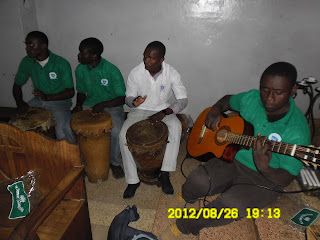Three years ago I got on a plane with very little idea of where I'd be living or what I'd be doing for what I thought would only be two years. Though it was a tearful farewell...well...I was too excited to ever reconsider or second-guess my decision. And I haven't really looked back at all.
Except now. Since looking back is now looking forward.
I'm terrified.
Venturing into the great unknown with almost no preparation (remember, I was on a plane to Turkmenistan the week before I got to Moz)? Exploring strange new places and meeting strange new strangers? Forcing myself to learn another language in order to survive on a daily basis? I'll take it!
It wasn't any sort of bravery that brought me here in the first place - it was part boredom, part wanting to see more of the world, part wanting to have a job in my field without having to cover dog and pony shows as an entry-level reporter at a local paper.
...But what happens now?
Nine-to-five desk job with hour-long morning commute? Sterile grocery stores where finding a box of Corn Flakes suddenly isn't the highlight of my week? Getting in trouble with police for standing on the side of the road and waving my hand in an attempt to get a free ride to the other side of the country? What happens when I go from being "whoa, a white girl!" to just another white girl? When having a college degree is a given instead of a specialty? When every day isn't a constant challenge just to get by? Will all the personal growth I've experienced over the past few years slowly melt away along with my Portuguese?
Completely new experiences are always worth the risk. Even if things go horribly wrong, at least you'll end up with a lesson learned and some great stories. But do I have the courage and motivation to go back to what I already know, and try to make the best of it? Do I have the guts to sleep in my high school bedroom (still adorned with Luke Skywalker and Harry Potter) while waitressing tables and filling out countless applications for jobs and schools? Am I brave enough to start at whatever entry-level position I can find, no matter how mundane it might seem?
I know life in the States has so much to offer and that - especially now - I'll do everything I can to make the most of it. I also know how many times I complain about the guy sitting on top of me in the chapa not wearing deoderant, and the criancas chasing me up the street shouting "muzungo!," and arriving at a big project meeting only to find no one else came because it was raining. Moreover, I know I'm going back to an incredible system of support from family and friends that I've sorely neglected over the past two years, and I can't wait to make up for lost time and see how much they've changed and grown.
At the same time, I'm giving up a job that I could see myself doing for life. I'm quitting a beautiful culture and a simpler way of life that I've finally come to understand and even adore. I'm moving out of my own three bedroom house with a yard full of cherimoya, guava, papaya, grapes and passionfruit. I'm acabar-ing being able to constantly improve my second language. I'm leaving behind some of the people on which I depended on a daily basis. Once again, I'm ending a relationship to move continents.
So bear with me. Be patient when I start every other sentence with "In Mozambique..." Don't laugh when I ask where the bucket is to take a shower. Correct me when I use "negar," "ja," "conseguir," and "epa!" in daily conversation. Don't judge me when I use half a bottle of oil to fry an egg. Remind me that people still like me even though I don't get three marriage proposals a day.
I've put off returning long enough - even signing up for another year in a new province. The easy, cowardly thing to do would be to just go to another country and see what trouble I can get into there. But I'm going to try to be brave. I'm going to say farewell and boldy go where I've been before. I'm going home.


.jpg)
.jpg)
.jpg)
.jpg)

.jpg)
.jpg)





.jpg)







.jpg)
.jpg)
.jpg)
.jpg)
.jpg)
.jpg)


.jpg)
.jpg)



.jpg)
.jpg)
.jpg)
.jpg)
.jpg)
.jpg)
.jpg)
.jpg)
.jpg)
.jpg)
.jpg)
.jpg)
.jpg)
.jpg)
.jpg)
.jpg)
.jpg)
.jpg)
.jpg)
.jpg)

.jpg)